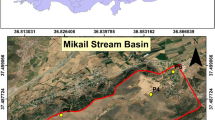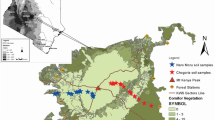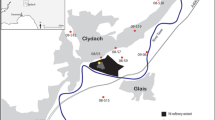Abstract
This study illustrates the inconsistencies that may result from using different background values and conservative elements in the calculation of enrichment factors. By using 75 soil samples collected from agricultural lands adjacent to Mau and Aberdare forests, Zn and Cu enrichments was assessed using enrichment factor. The geochemical background values used for this study were concentrations of the upper continental crust (UCC), logarithmized UCC concentrations and concentrations of elements in soils from the forested lands as the local background values. Calcium, Mn, and Fe were used as the conservative elements. In addition, Cu and Zn geoaccumulation index was determined for comparison purpose. When UCC values were applied, the average Cu enrichment was 0.24, 1.42 and 15.3 when Mn, Ca and Fe were used as the conservative elements, respectively. The average Zn enrichment was 0.6 when Mn was used, and increased to 4.53 and 31.3 Ca and Fe was used, respectively. Compared to Mn and Ca, Fe resulted to higher enrichments. Application of local background values significantly reduced variation in Zn and Cu enrichments, as the average Zn and Cu enrichments were relatively similar regardless of the conservative element used. Based on this, Zn enrichment ranged from minimal to extreme while Cu enrichment ranged from minimal to high. Cu Igeo ranged from − 1.96 to 2.49 while Zn Igeo ranged from − 2.74 to 2.11, implying that the soils ranged from not polluted to moderately polluted. Zn and Cu contamination levels in the agricultural soils was best evaluated using local geochemical baselines.



Similar content being viewed by others
Data Availability
Not applicable.
Code Availability
Not applicable.
References
Sinex S, Helz G (1981) Regional geochemistry of trace elements in Chesapeake Bay sediments. Environ Geol 3:315–323. https://doi.org/10.1007/BF02473521
Hakanson L (1980) An ecological risk index for aquatic pollution control. A sedimentological approach. Water Res 14:975–1001. https://doi.org/10.1016/0043-1354(80)90143-8
Qingjie G, Jun D, Yunchuan X, Qingfei W, Liqiang Y (2008) Calculating pollution indices by heavy metals in ecological geochemistry assessment and a case study in parks of Beijing. J China Univ Geosci 19:230–241. https://doi.org/10.1016/S1002-0705(08)60042-4
Barbieri M (2016) The importance of enrichment factor (EF) and geoaccumulation index (Igeo) to evaluate the soil contamination. J Geol Geophys 5:1–4. https://doi.org/10.4172/2381-8719.1000237
Poh S-C, Tahir NM (2017) The common pitfall of using enrichment factor in assessing soil heavy metal pollution. Malays J Anal Sci 21:52–59. https://doi.org/10.17576/mjas-2017-2101-07
Reimann C, Caritat Pd (2000) Intrinsic flaws of element enrichment factors (EFs) in environmental geochemistry. Environ Sci Technol 34:5084–5091. https://doi.org/10.1021/es001339o
Loska K, Wiechuła D, Pelczar J (2005) Application of enrichment factor to assessment of zinc enrichment/depletion in farming soils. Commun Soil Sci Plant Anal 36:1117–1128. https://doi.org/10.1081/CSS-200056880
Loska K, Wiechula D, Barska B, Cebula E, Chojnecka A (2003) Assessment of arsenic enrichment of cultivated soils in Southern Poland. Pol J Environ Stud 12:187–192
Bern CR, Walton-Day K, Naftz DL (2019) Improved enrichment factor calculations through principal component analysis: examples from soils near breccia pipe uranium mines, Arizona, USA. Environ Pollut 248:90–100. https://doi.org/10.1016/j.envpol.2019.01.122
Blaser P, Zimmermann S, Luster J, Shotyk W (2000) Critical examination of trace element enrichments and depletions in soils: As, Cr, Cu, Ni, Pb, and Zn in Swiss forest soils. Sci Total Environ 249:257–280. https://doi.org/10.1016/S0048-9697(99)00522-7
Desaules A (2012) Critical evaluation of soil contamination assessment methods for trace metals. Sci Total Environ 426:120–131. https://doi.org/10.1016/j.scitotenv.2012.03.035
Reimann C, de Caritat P (2005) Distinguishing between natural and anthropogenic sources for elements in the environment: regional geochemical surveys versus enrichment factors. Sci Total Environ 337(1–3):91–107. https://doi.org/10.1016/j.scitotenv.2004.06.011
Shifaw E (2018) Review of heavy metals pollution in China in agricultural and urban soils. J Health Pollut 8:180607. https://doi.org/10.5696/2156-9614-8.18.180607
Anderson RH, Kravitz MJ (2010) Evaluation of geochemical associations as a screening tool for identifying anthropogenic trace metal contamination. Environ Monit Assess 167:631–641. https://doi.org/10.1007/s10661-009-1079-2
Reimann C, Garrett RG (2005) Geochemical background—concept and reality. Sci Total Environ 350(1–3):12–27. https://doi.org/10.1016/j.scitotenv.2005.01.047
de Caritat P, Reimann C, Smith DB, Wang X (2018) Chemical elements in the environment: multi-element geochemical datasets from continental-to national-scale surveys on four continents. Appl Geochem 89:150–159. https://doi.org/10.1016/j.apgeochem.2017.11.010
Reimann C, de Caritat P (2017) Establishing geochemical background variation and threshold values for 59 elements in Australian surface soil. Sci Total Environ 578:633–648. https://doi.org/10.1016/j.scitotenv.2016.11.010
Abrahim G, Parker R (2008) Assessment of heavy metal enrichment factors and the degree of contamination in marine sediments from Tamaki Estuary, Auckland, New Zealand. Environ Monit Assess 136:227–238. https://doi.org/10.1007/s10661-007-9678-2
Kowalska JB, Mazurek R, Gąsiorek M, Zaleski T (2018) Pollution indices as useful tools for the comprehensive evaluation of the degree of soil contamination—a review. Environ Geochem Health 40:2395–2420. https://doi.org/10.1007/s10653-018-0106-z
Jain C (2004) Metal fractionation study on bed sediments of River Yamuna, India. Water Res 38:569–578. https://doi.org/10.1016/j.watres.2003.10.042
Thuong NT, Yoneda M, Shimada Y, Matsui Y (2015) Assessment of trace metal contamination and exchange between water and sediment systems in the To Lich River in inner Hanoi, Vietnam. Environ Earth Sci 73:3925–3936. https://doi.org/10.1007/s12665-014-3678-7
Githaiga KB, Njuguna SM, Makokha VA, Wang J, Gituru RW, Yan X (2020) Assessment of Cu, Zn, Mn, and Fe enrichment in Mt. Kenya soils: evidence for atmospheric deposition and contamination. Environ Monit Assess 192:167. https://doi.org/10.1007/s10661-020-8123-7
Bourennane H, Douay F, Sterckeman T, Villanneau E, Ciesielski H, King D, Baize D (2010) Mapping of anthropogenic trace elements inputs in agricultural topsoil from Northern France using enrichment factors. Geoderma 157:165–174. https://doi.org/10.1016/j.geoderma.2010.04.009
Bacardit M, Camarero L (2010) Atmospherically deposited major and trace elements in the winter snowpack along a gradient of altitude in the Central Pyrenees: the seasonal record of long-range fluxes over SW Europe. Atmos Environ 44:582–595. https://doi.org/10.1016/j.atmosenv.2009.06.022
Alloway BJ (2008) Zinc in soils and crop nutrition, 2nd edn. IZA and IFA, Brussels
Reimann C, Fabian K, Flem B, Englmaier P (2019) The large-scale distribution of Cu and Zn in sub-and topsoil: separating topsoil bioaccumulation and natural matrix effects from diffuse and regional contamination. Sci Total Environ 655:730–740. https://doi.org/10.1016/j.scitotenv.2018.11.248
Kelepertzis E (2014) Accumulation of heavy metals in agricultural soils of Mediterranean: insights from Argolida basin, Peloponnese, Greece. Geoderma 221:82–90. https://doi.org/10.1016/j.geoderma.2014.01.007
Keshavarzi A, Kumar V (2019) Ecological risk assessment and source apportionment of heavy metal contamination in agricultural soils of Northeastern Iran. Int J Environ Health Res 29:544–560. https://doi.org/10.1080/09603123.2018.1555638
He ZL, Yang XE, Stoffella PJ (2005) Trace elements in agroecosystems and impacts on the environment. J Trace Elem Med Biol 19:125–140. https://doi.org/10.1016/j.jtemb.2005.02.010
Fagnano M et al (2020) Copper accumulation in agricultural soils: Risks for the food chain and soil microbial populations. Sci Total Environ 734:139434. https://doi.org/10.1016/j.scitotenv.2020.139434
Li X et al (2020) Status of copper accumulation in agricultural soils across China (1985–2016). Chemosphere 244:125516. https://doi.org/10.1016/j.chemosphere.2019.125516
Baran A, Wieczorek J, Mazurek R, Urbański K, Klimkowicz-Pawlas A (2018) Potential ecological risk assessment and predicting zinc accumulation in soils. Environ Geochem Health 40:435–450. https://doi.org/10.1007/s10653-017-9924-7
Acosta J, Faz A, Martínez-Martínez S, Arocena J (2011) Enrichment of metals in soils subjected to different land uses in a typical Mediterranean environment (Murcia City, southeast Spain). Appl Geochem 26:405–414. https://doi.org/10.1016/j.apgeochem.2011.01.023
Nicholson FA, Smith SR, Alloway B, Carlton-Smith C, Chambers B (2003) An inventory of heavy metals inputs to agricultural soils in England and Wales. Sci Total Environ 311:205–219. https://doi.org/10.1016/S0048-9697(03)00139-6
Reimann C, Fabian K, Birke M, Filzmoser P, Demetriades A, Négrel P, Oorts K, Matschullat J, de Caritat P, Albanese S (2018) GEMAS: Establishing geochemical background and threshold for 53 chemical elements in European agricultural soil. Appl Geochem 88:302–318. https://doi.org/10.1016/j.apgeochem.2017.01.021
Bhat MM, Narain K, Shukla R, Yunus M (2013) Apportionment of pollution loads arising from catchments in pond water bodies. Adv Appl Sci Res 4:436–441
Wedepohl KH (1995) The composition of the continental crust. Geochim Cosmochim Acta 59:1217–1232. https://doi.org/10.1016/0016-7037(95)00038-2
Saviozzi A, Levi-Minzi R, Cardelli R, Riffaldi R (2001) A comparison of soil quality in adjacent cultivated, forest and native grassland soils. Plant Soil 233:251–259. https://doi.org/10.1023/A:1010526209076
Adejuwon J, Ekanade O (1988) A comparison of soil properties under different land use types in a part of the Nigerian cocoa belt. CATENA 15:319–331
Balota EL, Yada IFU, Amaral HF, Nakatani AS, Hungria M, Dick RP, Coyne MS (2015) Soil quality in relation to forest conversion to perennial or annual cropping in southern Brazil. Rev Bras Ciênc Solo 39:1003–1014. https://doi.org/10.1590/01000683rbcs20140675
Evrendilek F, Celik I, Kilic S (2004) Changes in soil organic carbon and other physical soil properties along adjacent Mediterranean forest, grassland, and cropland ecosystems in Turkey. J Arid Environ 59:743–752. https://doi.org/10.1016/j.jaridenv.2004.03.002
Xu Y, Yu W, Ma Q, Zhou H (2013) Accumulation of copper and zinc in soil and plant within 10-year application of different pig manure rates. Plant Soil Environ 59:492–499. https://doi.org/10.17221/121/2013-PSE
Were K, Singh BR, Dick ØB (2016) Spatially distributed modelling and mapping of soil organic carbon and total nitrogen stocks in the Eastern Mau Forest Reserve, Kenya. J Geog Sci 26:102–124. https://doi.org/10.1007/s11442-016-1257-4
Olang LO, Kundu PM (2011) Land degradation of the Mau forest complex in Eastern Africa: a review for management and restoration planning. Environ Monit. https://doi.org/10.5772/28532
Lambrechts C, Woodley B, Church C, Gachanja M (2003) Aerial survey of the destruction of the Aberdare Range forests Division of Early Warning and Assessment, UNEP
Aksa D, Tanaka N, Ohta S, Effendi S (2000) Characteristics of soils developed on volcanic parent materials in the Barong Tongkok Area. In: Rainforest ecosystems of East Kalimantan. Springer, pp 89–96. https://doi.org/10.1007/978-4-431-67911-0_8.
Bewernick T (2016) Mapping forest degradation in the Mau Forest Complex using NDFI time series. Wageningen University and Research Centre, The Netherlands.
Louppe D, Depommier D, Kabengi M (2009) Rehabilitation of the Aberdare forest ecosystem. A project implemented by the Green Belt Movement and supported by the French Agency for Development: a report of the mid term review mission (CIRAD Consultancy team, Nairobi, September, 17–October 02, 2009)
Swart R (2016) Monitoring 40 years of land use change in the Mau Forest Complex, Kenya. A land use change driver analysis
Kaniaru MP (2013) The Effect of tea growing on forest degradation in Chinga area of The Aberdare Ranges in Nyeri County, Kenya Kenyatta University
ISO (1995) International Standard Organization (ISO) 11466: Soil quality-Extraction of trace elements soluble in aqua regia. ISO Genebra
Maina CW, Sang JK, Raude JM, Mutua BM (2019) Geochronological and spatial distribution of heavy metal contamination in sediment from Lake Naivasha, Kenya. J Radiat Res Appl Sci 12:37–54. https://doi.org/10.1080/16878507.2019.1593718
Olando G, Olaka LA, Okinda PO, Abuom P (2020) Heavy metals in surface sediments of Lake Naivasha, Kenya: spatial distribution, source identification and ecological risk assessment. SN Appl Sci 2:279. https://doi.org/10.1007/s42452-020-2022-y
Kabata-Pendias A, Mukherjee AB (2007) Trace elements from soil to human. Springer Science & Business Media. https://doi.org/10.1007/978-3-540-32714-1
Rudnick R, Gao S, Holland H, Turekian K (2003) Composition of the continental crust. In: Holland HD, Turekian KK (eds) Treatise on Geochemistry. The crust, vol 3, pp 1–64. https://doi.org/10.1016/B0-08-043751-6/03016-4.
Bounouira H et al (2018) Study of heavy metal assessment in the Gharb plain along Sebou river (Morocco) using k0-NAA method at the Moroccan Triga Mark II research reactor. Ann Agrar Sci 16:376–388. https://doi.org/10.1016/j.aasci.2018.08.002
Chen H, Teng Y, Lu S, Wang Y, Wang J (2015) Contamination features and health risk of soil heavy metals in China. Sci Total Environ 512:143–153. https://doi.org/10.1016/j.scitotenv.2015.01.025
Muller G (1969) Index of geoaccumulation in sediments of the Rhine River. GeoJournal 2:108–118
Slessarev E, Lin Y, Bingham N, Johnson J, Dai Y, Schimel J, Chadwick O (2016) Water balance creates a threshold in soil pH at the global scale. Nature 540:567–569. https://doi.org/10.1038/nature20139
Han J, Shi J, Zeng L, Xu J, Wu L (2015) Effects of nitrogen fertilization on the acidity and salinity of greenhouse soils. Environ Sci Pollut Res 22:2976–2986. https://doi.org/10.1007/s11356-014-3542-z
Zhou J, Xia F, Liu X, He Y, Xu J, Brookes PC (2014) Effects of nitrogen fertilizer on the acidification of two typical acid soils in South China. J Soils Sediments 14:415–422. https://doi.org/10.1007/s11368-013-0695-1
Gerald A, Zeynab W (2019) Kenya's soils are too acidic for growing crops,study reveals. Nation media Group, Nairobi. p 10
Akenga P, Salim A, Onditi A, Yusuf A, Waudo W (2014) Determination of selected micro and macronutrients in sugarcane growing soils at Kakamega North District, Kenya. IOSR J Appl Chem 7:34–41
Mungai TM, Owino AA, Makokha VA, Gao Y, Yan X, Wang J (2016) Occurrences and toxicological risk assessment of eight heavy metals in agricultural soils from Kenya, Eastern Africa. Environ Sci Pollut Res 23:18533–18541. https://doi.org/10.1007/s11356-016-7042-1
Wanjala F, Hashim N, Otwoma D, Nyambura C, Kebwaro J, Ndege M, Bartilol S (2020) Environmental assessment of heavy metal pollutants in soils and water from Ortum, Kenya. Environ Monit Assess 192:1–15. https://doi.org/10.1007/s10661-020-8070-3
Ndungu AW, Yan X, Makokha VA, Githaiga KB, Wang J (2019) Occurrence and risk assessment of heavy metals and organochlorine pesticides in surface soils, Central Kenya. J Environ Health Sci Eng 17:63–73. https://doi.org/10.1007/s40201-018-00326-x
Ngure V, Sitati N, Shisia S, Kinuthia G (2015) Assessment of heavy metals pollution in urban soils and the implications to consumers health Assessment 5
Tóth G, Hermann T, Da Silva M, Montanarella L (2016) Heavy metals in agricultural soils of the European Union with implications for food safety. Environ Int 88:299–309. https://doi.org/10.1016/j.envint.2015.12.017
Kamunda C, Mathuthu M, Madhuku M (2016) Health risk assessment of heavy metals in soils from Witwatersrand Gold Mining Basin, South Africa. Int J Environ Res Public Health 13:663. https://doi.org/10.3390/ijerph13070663
CCME (1999) Canadian Soil Quality Guidelines for the Protection of Environmental and Human Health
Reimann C, Filzmoser P, Hron K, Kynčlová P, Garrett R (2017) A new method for correlation analysis of compositional (environmental) data—a worked example. Sci Total Environ 607:965–971. https://doi.org/10.1016/j.scitotenv.2017.06.063
Caporale AG, Violante A (2016) Chemical processes affecting the mobility of heavy metals and metalloids in soil environments. Curr Pollut Rep 2:15–27. https://doi.org/10.1007/s40726-015-0024-y
Thorpe A, Harrison RM (2008) Sources and properties of non-exhaust particulate matter from road traffic: a review. Sci Total Environ 400:270–282. https://doi.org/10.1016/j.scitotenv.2008.06.007
Ediagbonya T (2016) Enrichment factor of atmospheric trace metal using zirconium titanium iron and copper as reference element. Niger J Technol 35:785–795. https://doi.org/10.4314/njt.v35i4.13
Gałuszka A (2007) A review of geochemical background concepts and an example using data from Poland. Environ Geol 52:861–870. https://doi.org/10.1007/s00254-006-0528-2
Sucharovà J, Suchara I, Hola M, Marikova S, Reimann C, Boyd R, Filzmoser P, Englmaier P (2012) Top-/bottom-soil ratios and enrichment factors: what do they really show? Appl Geochem 27(1):138–145. https://doi.org/10.1016/j.apgeochem.2011.09.025
Acknowledgements
This work was supported by Sino-Africa Joint Research Center (number: SAJC202102), Chinese Academy of Sciences and National Natural Sciences of China, (number: NSFC 31361140360) and the Chinese Academy of Science—The World Academy of Science (CAS-TWAS) presidential fellowship.
Funding
This work was supported by Sino-Africa Joint Research Center (Number: SAJC202102), Chinese Academy of Sciences and National Natural Sciences of China, (Number: NSFC 31361140360) and the Chinese Academy of Science—The World Academy of Science (CAS-TWAS) presidential fellowship.
Author information
Authors and Affiliations
Contributions
Project idea and proposal writing by KBG and XY; project approval and funds acquisition by XY; fieldwork and data collection by KBG and SMN; data analysis by KBG and SMN; manuscript writing by KBG; manuscript review and correction by all the authors.
Corresponding author
Ethics declarations
Conflict of interest
The authors declare that they have no conflict of interest.
Supplementary Information
Below is the link to the electronic supplementary material.
Rights and permissions
About this article
Cite this article
Githaiga, K.B., Njuguna, S.M. & Yan, X. Local Geochemical Baselines Reduce Variation Caused by the Use of Different Conservative Elements in Predicting Cu and Zn Enrichment in Agricultural Soils, Kenya. Chemistry Africa 4, 869–880 (2021). https://doi.org/10.1007/s42250-021-00256-6
Received:
Accepted:
Published:
Issue Date:
DOI: https://doi.org/10.1007/s42250-021-00256-6




